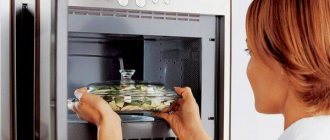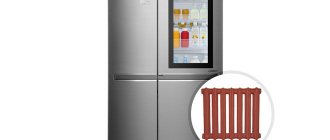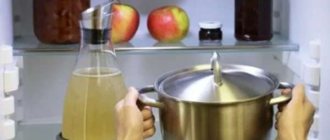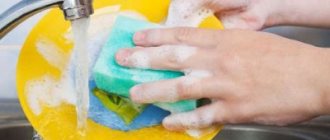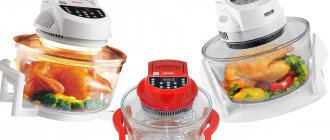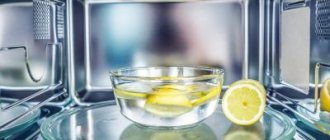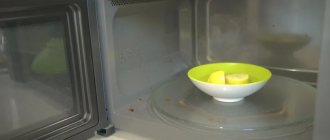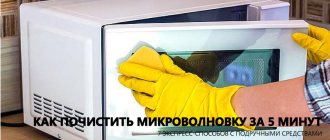If you've ever seen what looks like a miniature lightning bolt in your microwave, it's because you put something metal in it. Metals and microwaves have a complicated relationship. What metal can be used in a microwave oven?
Can you put stainless steel in the microwave? It is best not to place stainless steel in the microwave because the metal reflects microwaves rather than absorbing them. This may cause sparking and fire. This is especially dangerous if the metal has a complex shape, such as forks, or if there is more than one piece of metal present.
In this article, you will learn why putting stainless steel in the microwave is dangerous and why in some cases it is not.
Is it possible to cook in foil in a slow cooker?
A multicooker is not a microwave; you can safely put foil in it. It is very convenient to bake fish, meat, chicken and vegetables in foil.
Interesting materials:
Where can kittens be placed? Where can you go at night in St. Petersburg? Where can you go for a weekend getaway from Tyumen? Where can you go for free in St. Petersburg? Where can you go at night in Tyumen? Where can teenagers go in Minsk? Where can you throw out your emotions? Where does Jack Sparrow go at the end of Pirates of the Caribbean at World's End? Where should I go to apply for a passport? Where can I contact about digital television?
Microwaves and metal
Before we take a closer look at why you should or shouldn't put stainless steel in your microwave, it's important to know how this extremely useful appliance works.
How do microwave ovens work?
Microwaves, as a type of radiation , fall between the categories of radio waves and infrared waves. These waves are absorbed by most foods, so they can be heated in seconds.
The atomic movement these waves create in the food causes it to heat evenly.
The only time a microwave will heat food unevenly is if it fails to create a ripple in the center of the dish, be it a large piece of meat or a pile of leftover pasta and sauce.
If you take a minute to distribute the food evenly on your plate, the problem will be solved.
The waves are absorbed by fat, sugar and water in food. There is a common misconception that a microwave oven cooks food from the inside, but this is not true.
If that were the case, you wouldn't have a hot pocket that melts on your face on the outside and a block of ice in the center.
Microwaves actually heat by causing loose molecules in food to spin , creating frictional energy that becomes heat. This heat is then evenly distributed through convection.
The misconception comes from the fact that this process heats the inside of food much faster than an oven, without browning or burning the edges.
What happens when you put metal in the microwave
Now that you know how a microwave oven works, understanding the complex relationship between a microwave oven and metal will be much easier.
Why shouldn't you put metal objects in the microwave?
Because heating food in a microwave oven occurs due to microwave waves; their strength is not enough to heat the metal, but it is enough to cause high-frequency alternating currents in a thin layer of this same metal.
It is these that we see in the form of sparks when the metal in the microwave begins to short out. Everything would be fine - just a beautiful and not very fireproof picture, if not for one thing. The operation of a microwave oven is based on a magnetron, which can fail if a large number of rays are scattered. The essence of heating is based on the fact that the waves absorb (boil) water molecules. They are not present in the metal, and as a result the waves are scattered, which disables the magnetron.
In other words, a small piece of foil in a huge bowl of soup is not dangerous for the microwave, but a large aluminum piece is very dangerous.
How to check that the plate fits
Dishes placed in the oven must fit exactly in size and not touch the walls or top. The diameter of the container should not extend beyond the rotating circle of the oven. If the vessel has handles, then they should also fit clearly into the space. A product of a smaller size is allowed; if it exceeds the required standards, then it is not suitable.
Marking on dishes.
Stainless steel microwave oven
Stainless steel, which is regular steel coated with a thin layer of chromium, is no different from other types of metal when it comes to putting it in the microwave. It reflects waves just like other metals.
A small, flat piece of stainless steel, when used correctly, is unlikely to cause a spark in a microwave oven. On the other hand, a stainless steel frying pan or fork will certainly work.
Additionally, if you place a stainless steel item too close to the metal walls of the microwave, it may cause severe sparking , damage to the microwave, or even a fire.
Stainless steel is a common material used in travel mugs. Do not attempt to heat these mugs in the microwave.
Not only will your drink stay cold due to the shield created by the metal, but it will also damage your magical kitchen appliances.
What else should you not put in the microwave?
If you and I lived in the USA, then each case of unauthorized use of a microwave would be documented and a separate law would be issued. For example, one woman decided to dry her cat in the microwave... now there is a law officially prohibiting this.
We do not recommend putting any modifications of the presence of metal into the microwave: foil, thermal mugs, old plates coated with metal, dishes. In addition, you should not put sponges or things, especially woolen ones, in the microwave, try to dry grass there, or heat food in paper bags.
I would also like to say something about chicken eggs. Trying to cook an egg in the microwave will most likely cause it to explode. This will not cause much harm to the microwave, except that you will be forced to wash it for an hour.
What dishes can and cannot be put in the microwave?
A microwave oven is a common element in almost any kitchen. It is easy to handle, but you need to follow important rules regarding permitted utensils. Heating food in the wrong plates will damage both the containers themselves and the electrical appliance.
Is it possible to put glassware in the microwave?
Glass plates are considered optimal for microwave use. The containers have sufficient heat resistance, do not crack at high temperatures, and do not form an electric arc when heated.
But it is recommended to choose special heat-resistant glass with thick walls for the microwave. Products that are too thin may crack after several uses under intense heat.
Simple glass plates without drawings or patterns are considered the best for microwave ovens.
Can I use crystal glassware?
Real crystal is not suitable for microwave use. Outwardly, it looks like glass, but it contains metals - lead and silver. As a result, crystal plates in the oven heat up very quickly and, at best, crack, and at worst, they damage the device itself.
Is it possible to put iron or enamel dishes in the microwave?
It is strictly prohibited to place metal containers in the oven. Products made of copper, aluminum and steel do not transmit microwaves, but reflect them and provoke the occurrence of an electric arc. The food remains cold, but sparks and lightning are formed inside the chamber, accompanied by a loud cracking sound. Such discharges damage the internal coating of the microwave oven and can damage the internal components of the device.
Warning! Enameled containers for microwaves are no more suitable than ordinary metal containers; they also lead to sparks.
Is it possible to put ceramic and earthenware dishes in the microwave?
Bowls and plates made of glazed ceramic and glass ceramic are well suited for use in the microwave. Materials do not lose strength when exposed to high temperatures, although they become very hot on their own.
At the same time, it is better not to put clay products without glaze in the microwave. They will heat up unevenly and may eventually crack due to the temperature difference. For the same reason, it is not recommended to use products where the glaze is applied only to the sides or bottom.
When removing ceramic containers from the microwave, be sure to use oven mitts
Is it possible to put plastic dishes in the microwave?
Plastic is not always suitable for the microwave. Containers for breakfast and lunch, made of hard, dense and heat-resistant material, can be placed in the oven. Plates made of thin plastic, which easily bends and breaks in the hand, are not suitable for microwaves. They are not designed for elevated temperatures and will simply melt.
Advice! You can look for the microwave icon on plastic dishes; if it is present, the container can be placed in the oven without hesitation.
Is it possible to heat disposable tableware in the microwave?
There are two types of disposable plates - plastic and paper. Thin plastic products cannot be placed in the microwave; they will heat up, melt and actively release toxic substances.
But paper containers are designed for high-temperature exposure. Many semi-finished products are sold directly in such trays; they can be heated without transferring them to another container.
Why you can’t use wooden or bamboo dishes in the microwave
Eco-friendly bamboo and wooden plates are very popular and look quite durable and reliable. But they are not suitable for the microwave oven.
Bamboo absorbs moisture very well even without direct contact with it, just when it is in the kitchen. When heated, microparticles of water inside the walls boil and evaporate. The bamboo expands and cracks.
Wooden dishes can be used to microwave food occasionally, in short bursts. Most likely, nothing will happen to the product in one go. But if you put wooden containers in the microwave too often, the material will dry out, gradually deteriorate from the inside and become covered with cracks.
If left in the microwave for a long time, wooden plates can char and catch fire.
Why should you not use dishes with a gold rim?
Because glassware is microwave safe, many people look solely at the base material of the item and don't pay attention to the decorative elements. But containers with a gold or silver rim cannot be placed in the microwave.
Shiny paints contain metal particles. And although the amount of the latter is small, it is enough to cause electrical discharges in a microwave oven.
Attention! Patterned containers made from regular microwave paint are usually suitable and will not create sparks.
What does the icon on microwave cookware mean and how to decipher it?
There is a special marking on the dishes that informs the user whether the container can be used in microwave ovens. Please note the variety of notations. Please note the photo of the markings below.
This is how plastic utensils are marked, indicating the composition of the product and its suitability for microwave use.
If you see crossed out icons with the image of microwaves, then the container is not suitable for heating food in the microwave.
Pay attention to what properties microwave cookware should have.
What dishes should not be put in the microwave: comments from the editorial experts
When choosing dishes for the microwave, consultants will show you options of various volumes and shapes. But these are not so important conditions on which the performance of the microwave and your safety depend.
Metal containers are unsafe
Metal and enamel bowls and cups in a working microwave endanger your health. The presence of iron parts in the cookware, not to mention the base of the container, is extremely dangerous for use. The fact is that microwaves do not pass through iron, but, on the contrary, are reflected from it. Accordingly, this phenomenon causes a microwave error, accompanied by sparking and frequent failure of the device.
Utensils with drawings and ornaments
To avoid testing the microwave's performance, avoid plates with gold-plated edges. Agree, it is not known for certain what dyes were used to create such dishes. It is likely that it also contains elements of some metals, and this, as a result, is not permissible for microwave ovens.
Therefore, in order not to take risks, you should refuse containers with such appearance features.
Luxurious crystal is not for the microwave!
An uneven design of the cookware can cause it to split into small pieces. In the production of crystal tableware, which is often a component of antique sets, silver and lead are used, as well as some other natural metals. In addition, due to the cut surface of the cookware, it may crack under the influence of microwaves.
The real reason: why you shouldn't put metal utensils in the microwave?
If the owner violates the rules for operating a microwave oven, no one will repair the device for free. Almost every second owner of a microwave oven had to deal with the problem of having iron cutlery in a working device. It’s good if everything ended well, but events could have developed even more dangerously.
For example, a breakdown of the device, injury to the owner (electric shock), a short circuit and, as a result, a fire. Metal is not able to pass the waves of a microwave device through itself, but repels them back, thereby destroying the functionality of the electrical device.
Requirements for microwave oven dishes when using combined modes
Using containers for microwave ovens is a very important task, so some requirements must be observed. For detailed information, we offer you a detailed video review, which details the main criteria that cookware for microwave ovens must meet.
Metal and microwave
It is strictly forbidden to place iron utensils in the microwave. The reflective properties of the metal surface block the passage of microwaves through the walls of the container, which causes electrical discharge. If the impact is too strong, the oven mechanism will become unusable. In the most severe cases, an explosion may even occur, since the built-in magnetron cannot cope with the load.
When figuring out whether it is possible to put iron utensils in the microwave, stove owners must keep in mind that it is not only plates and bowls that cannot be used. It is also necessary to ensure that metal spoons, forks, and knives do not get inside.
To the question: “Can I put iron dishes in the microwave?” The answer is clear: “No.” Even plates and cups with gold or silver rims create sparks. A discharge of such force cannot damage the oven itself, but it will leave unsightly dark spots on the plates.
The right dishes for the microwave
How to choose dishes for the microwave and not make a mistake? Any containers made of heat-resistant glass and heat-resistant plastic are suitable for microwaves. Ordinary ceramic cups and plates can also be used to heat food, but it is still not recommended to cook in them: excessive heating may cause the walls to burst and fragments will fall into the food. For the convenience of users, there are special disposable forms made of thick pressed paper. Plastic containers intended for storing food usually have markings on them that indicate whether the container can be heated in an oven.
Dishes used in the oven must be clean, free of greasy splashes or deposits. When heated, dirt can smoke, which will certainly spoil the quality of food. You also need to carefully monitor the cleanliness of the internal walls of the microwave in order to maximize its service life. Regularly remove plaque from the internal walls, having first disconnected the device from the power supply. To soften the hardest stains, pour water into a large container, add 20 grams of baking soda and 20 ml of table vinegar. Place the liquid inside the microwave and boil for 3-5 minutes. After this, you can proceed directly to cleaning.
Now you know whether you can put iron cookware in the microwave. By abandoning metal in favor of ceramics, porcelain and plastic, you will extend the life of the microwave.
Precautionary measures
In addition to the fact that a microwave oven is extremely convenient to use, and even a child can warm up their own food, there are still some precautions that must be observed:
- Do not place dishes with a gold rim in a microwave oven - the coating may begin to spark and lead to destruction of the dishes;
- Water in a microwave oven heats up very quickly to boiling point and can leak out, so there is a high probability that water from a vessel with a narrow neck will simply flow out and can burn your hands. Therefore, care must be taken not to overheat the liquid;
- Do not heat whole bird eggs or liquid in a closed container in a microwave oven. Under the influence of evaporation, strong pressure is created inside, which can provoke an explosion of the heated object;
- You cannot turn on an empty microwave; there must be at least a glass of water there;
- Under no circumstances should metal utensils or utensils be placed or heated in a microwave oven; this may lead to unforeseen consequences.
Is it possible to put iron utensils or dishes in foil in the microwave?
Any store, of course, sells dishes specially designed for microwave ovens. It is usually made from fireproof glass, ceramics and special plastic. However, you should not immediately run out and buy it, especially since the prices of such utensils are quite high. You can rummage around in your kitchen, and you will definitely find something suitable there.
Microwave-safe utensils are found in every kitchen.
Placing Metal in the Microwave - What You Should Know
If you're not going to read this section, the only thing you should take away is that it's best not to put metal in the microwave unless you're sure it's safe to do so.
If you want to do this correctly, please read the instructions. This applies not only to the instructions for the device you are using, but also to the food you are heating, if the latter refers to products that come in a particular package.
First of all, the manual that came with your appliance will set out the ground rules that you need to follow. It is important to know what is possible and what is not. put it in the microwave.
Last but not least, follow USDA guidelines whenever you are unsure about the safety of cooking a particular material in the microwave.


